
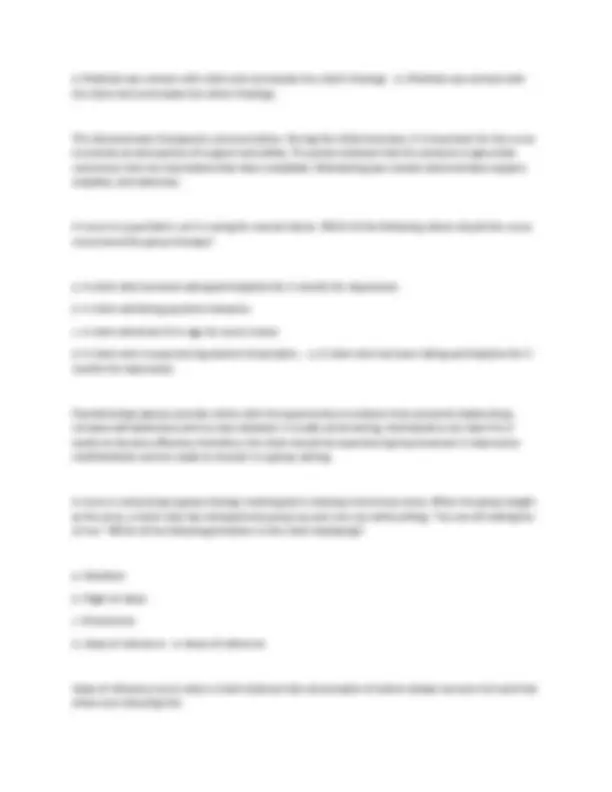
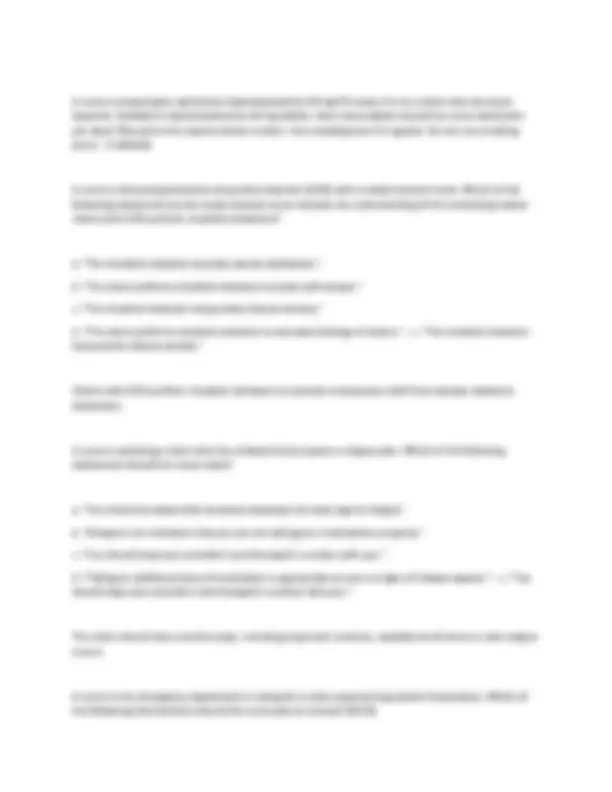
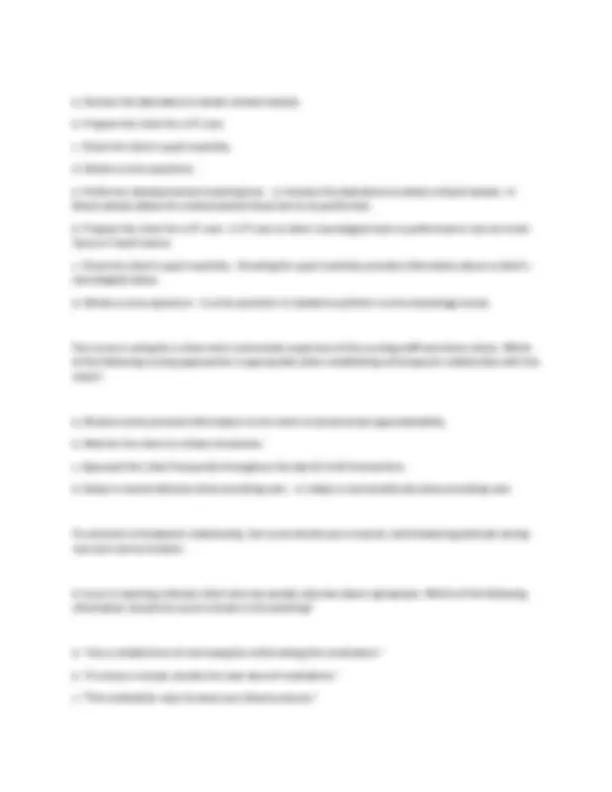
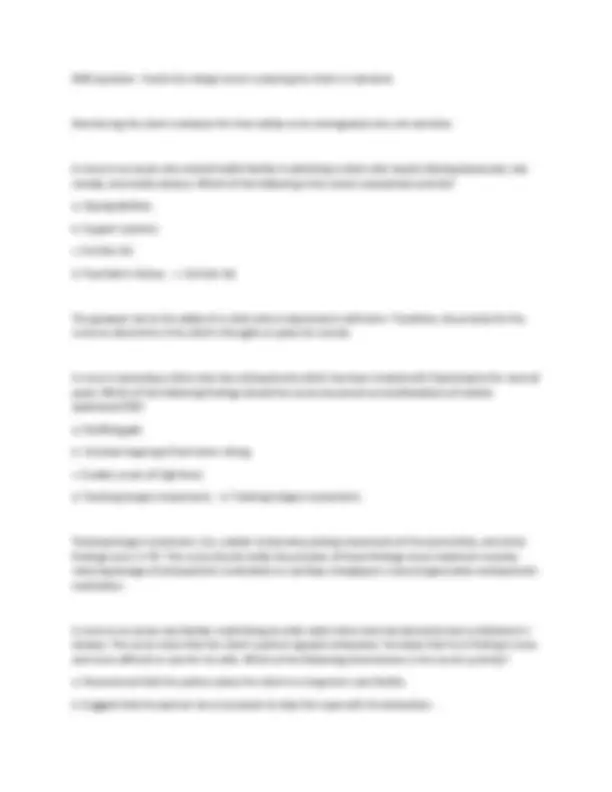
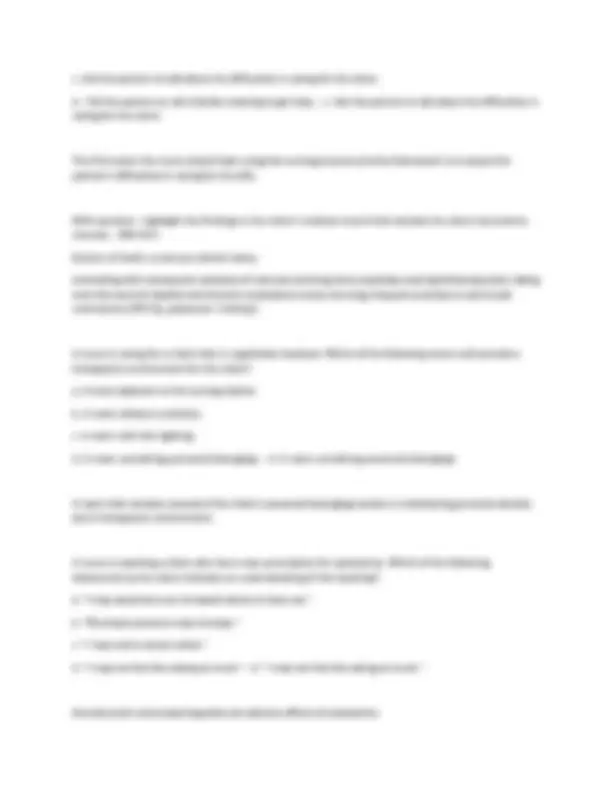
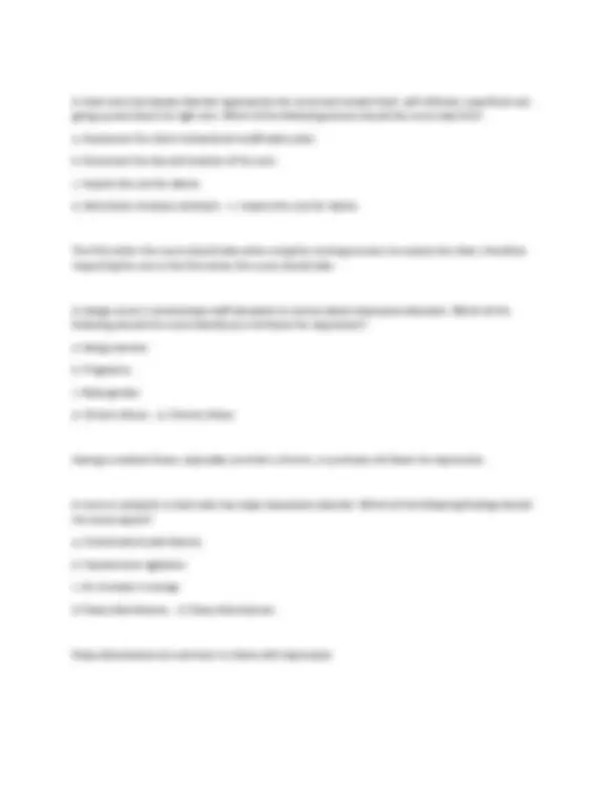


Study with the several resources on Docsity

Earn points by helping other students or get them with a premium plan


Prepare for your exams
Study with the several resources on Docsity

Earn points to download
Earn points by helping other students or get them with a premium plan
Community
Ask the community for help and clear up your study doubts
Discover the best universities in your country according to Docsity users
Free resources
Download our free guides on studying techniques, anxiety management strategies, and thesis advice from Docsity tutors
A nurse in a mental health clinic is assessing a client who was brought in by her adult daughter stating that her mother has not been able to leave her home for weeks because she is afraid to be outdoors alone. the nurse should anticipate planning care for managing which of the following phobias? a. Xenophobia b. Acrophobia c. Mysophobia d. Agoraphobia - d. Agoraphobia
Typology: Exams
1 / 11

This page cannot be seen from the preview
Don't miss anything!







ATI RN Capstone Mental Health Pre-Assessment | Comprehensive Questions and Answers Latest Updated 2024/2025 With 100% Verified Solutions A nurse in a mental health clinic is assessing a client who was brought in by her adult daughter stating that her mother has not been able to leave her home for weeks because she is afraid to be outdoors alone. the nurse should anticipate planning care for managing which of the following phobias? a. Xenophobia b. Acrophobia c. Mysophobia d. Agoraphobia - d. Agoraphobia Agoraphobia is an irrational fear about being in places or circumstances where the client would not have help in the event of panic or other forms of anxiety. Fear of being alone outdoor is a common example. A nurse is providing discharge teaching for a client who has multiple medication prescriptions and must take the medications at specific intervals when at home. Which of the following instructions should the nurse include in the teaching? a. "You really shouldn't change the schedule we established here in the facility." b. "Let's work together to devise a time schedule that is convenient for you on a daily basis." c. "We'll have to talk to your provider about switching to an alternative schedule." d. "It doesn't really matter what time you take your medications as long as you don't skip any doses." - b. "Let's work together to devise a time schedule that is convenient for you on a daily basis." This response illustrates the therapeutic communication technique of formulating a plan of action. It demonstrates the nurse's willingness to work with the client to modify the schedule so that it meets the client's needs at this time. A nurse is providing discharge teaching to. client who has bipolar disorder and will be discharged with a prescription for lithium. The nurse should teach the client that which of the following factors puts her at risk for lithium toxicity? a. The client runs 4 miles outdoors every afternoon. b. The client drinks 2 liters of liquids daily. c. The client eats 2 to 3 grams of sodium-containing foods daily.
d. The client eats foods high in tyramine. - a. The client runs 4 miles outdoors every afternoon. Strenuous exercise in outdoor heat, which can lead to dehydration, puts the client at risk for lithium toxicity. Mild to moderate exercise will not lead to lithium toxicity, but if the client engages in strenuous exercise during hot weather, she should take care to replace any water that may have been lost through profuse sweating. this also applies to other factors that can cause the client to become dehydrated, such as having diarrhea or taking diuretics. A nurse in a emergency department is assessing a client for suspected cocaine intoxication. Which of the following findings should the nurse expect? a. Nystagmus b. Dilated pupils c. Hypersomnia d. Depression - b. Dilated pupils Dilated pupils are a finding of cocaine intoxication due to the stimulation of the sympathetic nervous system. A nurse enters the room of a client who becomes verbally abusive. Which of the following actions should the nurse take? a. Inform the client of consequences. b. Speak slowly in a low, calm voice. c. Forbid the client from speaking in an abusive manner. d. Remain a distance of 1 ft away from the client. - b. Speak slowly in a low, calm voice. Speaking in this manner conveys to the client that the nurse is controlled, nonthreatening, and caring. A nurse is caring for a client who lost all his possessions in a house fire and states, "I have no idea what I am going to do. I cannot think right now." Which of the following actions should the nurse take? a. Identify other housing options and sources of transportation. b. Notify the facility chaplain to request scheduling an appointment. c. Confirm that everything will be alright because belongings can be replaced.
A nurse is preparing to administer diphenhydramine 50 mg PO every 6 hr to a client who has acute dystonia. Available is diphenhydramine 25 mg tablets. How many tablets should the nurse administer per dose? (Round to the nearest whole number. Use a leading zero if it applies. Do not use a trailing zero.) - 2 tablet(s) A nurse is discussing obsessive-compulsive disorder (OCD) with a newly licensed nurse. Which of the following statements by the newly licensed nurse indicates an understanding of the underlying reason clients with OCD perform ritualistic behaviors? a. "The ritualistic behavior provides sexual satisfaction." b. "The client performs ritualistic behavior to boost self-esteem." c. "The ritualistic behavior temporarily relieves anxiety." d. "The client performs ritualistic behavior to decrease feelings of shame." - c. "The ritualistic behavior temporarily relieves anxiety." Clients with OCD perform ritualistic behaviors to provide a temporary relief from anxiety related to obsessions. A nurse is assisting a client who has schizophrenia prepare a relapse plan. Which of the following statements should the nurse make? a. "You should be aware that excessive sleeping is an early sign of relapse." b. "Relapse is an indication that you are not taking your medications properly." c. "You should keep your provider's and therapist's number with you." d. "Taking an additional dose of medication is appropriate as soon as signs of relapse appear." - c. "You should keep your provider's and therapist's number with you." The client should have a written plan, including important numbers, available at all times in case relapse occurs. A nurse in the emergency department is caring for a client experiencing alcohol intoxication. Which of the following interventions should the nurse plan to include? (SATA)
a. Contact the laboratory to obtain a blood sample. b. Prepare the client for a CT scan. c. Check the client's pupil reactivity. d. Obtain a urine specimen. e. Performa. developmental screening test. - a. Contact the laboratory to obtain a blood sample - A blood sample allows for a blood alcohol level test to be performed. b. Prepare the client for a CT scan - A CT scan or other neurological tests is performed to rule out brain injury or head trauma. c. Check the client's pupil reactivity - Checking for pupil reactivity provides information about a client's neurological status. d. Obtain a urine specimen - A urine specimen is needed to perform a urine toxicology screen. The nurse is caring for a client who is extremely suspicious of the nursing staff and other clients. Which of the following nursing approaches is appropriate when establishing a therapeutic relationship with this client? a. Disclose some personal information to the client to demonstrate approachability. b. Wait for the client to initiate interaction. c. Approach the client frequently throughout the day for brief interactions. d. Adopt a neutral attitude when providing care. - d. Adopt a neutral attitude when providing care. To promote a therapeutic relationship, the nurse should use a neutral, nonthreatening attitude during care and communication. A nurse is teaching a female client who has anxiety disorder about alprazolam. Which of the following information should the nurse include in the teaching? a. "Use a reliable form of contraception while taking this medication." b. "If a dose is missed, double the next dose of medication." c. "This medication may increase your blood pressure."
A nurse is teaching a client who is scheduled for electroconvulsive therapy (ECT). Which of the following statements should the nurse include in the teaching? a. "You will require a breathing tube during the procedure." b. "There is a small chance you will have memory loss after this procedure." c. "There is little risk of having a seizure during this procedure." d. "You will receive IV or oral contrast prior to this procedure." - b. "There is a small chance you will have memory loss after this procedure." Some clients report memory loss for several weeks following the procedure. The nurse should inform the client that this effect usually resolves, but could possibly be permanent. A nurse is planning care for a client who has depression. The nurse notes that the client has weight loss, an inability to concentrate, an inability to complete everyday tasks, and a preference to sleep all day. Which of the following interventions should be included in the plan of care? a. Discourage rest periods during the daytime. b. Instruct family to avoid visiting during mealtimes. c. Offer three or four large meals daily. d. Give the client extra time to communicate needs. - d. Give the client extra time to communicate needs. Clients who have vegetative signs of depression have slowed thought processes and might take extra time to reply to questions or to verbalize thoughts. The nurse should display patience an give the client extra time to communicate. A nurse is caring for a client on an acute care mental health unit. Medical History: Client has a history of bipolar disorder and self-injurious behavior. Nurses Notes: 1330: Client pacing rapidly across their room and shouting loudly at nursing staff. Client appears agitated. Verbal de-escalation measures implemented. Client returned to their bed and is refusing to talk or make eye contact. 1345: Client displays self-injurious behavior by attempting to cut themselves with plastic utensils from their lunch tray.
NGN question - Assist the charge nurse in placing the client in restraints Monitoring the client's behavior for their ability to be reintegrated into unit activities A nurse in an acute care mental health facility is admitting a client who reports feeling depressed, sad, moody, and overly anxious. Which of the following is the nurse's assessment priority? a. Coping abilities. b. Support systems. c. Suicide risk. d. Psychiatric history. - c. Suicide risk The greatest risk to the safety of a client who is depressed is self-harm. Therefore, the priority for the nurse to determine is the client's thoughts or plans for suicide. A nurse is assessing a client who has schizophrenia which has been treated with fluphenazine for several years. Which of the following findings should the nurse document as manifestations of tardive dyskinesia (TD)? a. Shuffling gait. b. Constant tapping of feet when sitting. c. Sudden onset of high fever. d. Twisting tongue movements. - d. Twisting tongue movements. Twisting tongue movement, tics, sudden involuntary jerking movements of the extremities, and other findings occur in TD. The nurse should notify the provider of these findings since treatment includes reducing dosage of antipsychotic medications or perhaps changing to a second-generation antipsychotic medication. A nurse in an acute care facility is admitting an older adult client who has dementia due to Alzheimer's disease. The nurse notes that the client's partner appears exhausted. He states that he is finding it more and more difficult to care for his wife. Which of the following interventions is the nurse's priority? a. Recommend that the partner place the client in a long-term care facility. b. Suggest that the partner see a counselor to help him cope with his exhaustion.
A client who has bipolar disorder approaches the nurse and reveals fresh, self-inflicted, superficial cuts going up and down his right arm. Which of the following actions should the nurse take first? a. Implement the client's behavioral modification plan. b. Document the size and location of the cuts. c. Inspect the cuts for debris. d. Administer a tetanus antitoxin. - c. Inspect the cuts for debris. The first action the nurse should take when using the nursing process is to assess the client, therefore inspecting the cuts is the first action the nurse should take. A charge nurse is conducting a staff education in-service about depressive disorders. Which of the following should the nurse identify as a risk factor for depression? a. Being married. b. Pregnancy. c. Male gender. d. Chronic illness. - d. Chronic illness Having a medical illness, especially one that is chronic, is a primary risk factor for depression. A nurse is caring for a client who has major depressive disorder. Which of the following findings should the nurse expect? a. A dismissal of past failures. b. Psychomotor agitation. c. An increase in energy. d. Sleep disturbances. - d. Sleep disturbances. Sleep disturbances are common in clients with depression.
A nurse is assessing a parent who lost a 12-year-old child in a car crash 2 years ago. Which of the following findings indicates the client is exhibiting manifestations of prolonged grieving? a. Leaves the child's room exactly as it was before the loss. b. Volunteers at a local children's hospital. c. Talks about the child in the past tense. d. Visits the child's grave every week after worship services. - a. Leaves the child's room as it was before the loss. Grieving becomes dysfunctional when the client is unable to resume regular activities of daily living or experience emotions other than sadness or depression. An example of dysfunctional grieving is making the loved one's room a shrine for more than a year. A nurse is caring for an adolescent client who has conduct disorder. The client reports that she has received five speeding tickets in the past 6 months. Which of the following interventions should the nurse take? a. Make a contract with the client not to drive over the speed limit. b. Call the local police and alert them to the client's care license plate number and the make and model of the car. c. Ask the client to "hand over the keys" to you, and tell her that now she must use a cab or other public transportation until your next session. d. Inform the client that she cannot drink and drive. - a. Make a contract with the client not to drive over the speed limit. A behavior contract is appropriate to identify the expected behavior and consequences. The client, by signing the contract, assumes responsibility for her behavior.